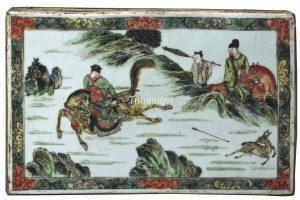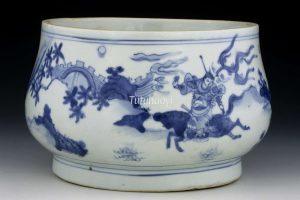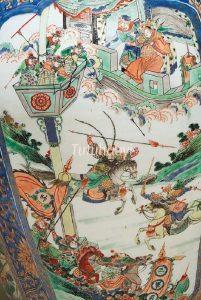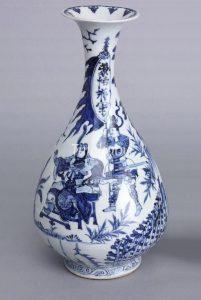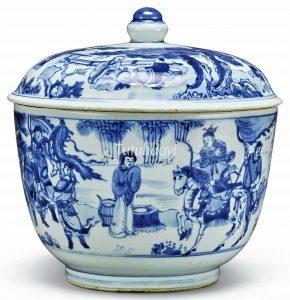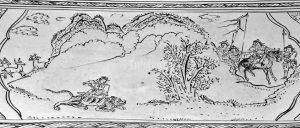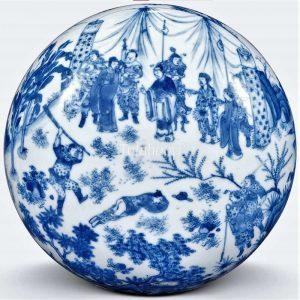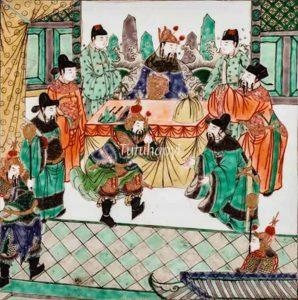Showing Results Containing
General Guo Ziyi deterring the mighty enemy has been a famous event in ancient China around mid-8th century. Deciphering this story scene on Chinese porcelain plates and tiles, however, has not been straightforward and has taken iconography specia...
The Royal Hunt at Xutian is a pivotal moment in Chapter 20 of Romance of the Three Kingdoms (《三国演义》) by Luo Guanzhong (罗贯中). This episode highlights Cao Cao (曹操) as a domineering minister who ‘held the emperor hostage to command the feudal lords.’
In this scene, Cao Cao arranges a hunting...
This scene is taken from Vol. 24 of the 14th-century Chinese historical novel Romance of the Three Kingdoms (三国演义 Sanguo Yanyi).
In the 15th year of Jian’an (AD 210), Cao Cao (曹操) completed the construction of Bronze Sparrow Terrace in Ye City (modern-day Handan, Hebei Province, China). To cele...
The true name of Guiguzi (鬼谷子) remains unknown due to insufficient historical records, although some suggest the name ‘Wang Yi’. Legend has it that Guiguzi was a figure from the Warring States period (475–221 BCE), renowned as both a recluse and a political thinker, strategist, and Daoist. He is considered the founder of...
According to the ‘Account of Zhao Yun’ (赵云传) in ‘The Records of the Three Kingdoms’ (三国志), Zhao Yun (styled Zilong, 子龙) was a distinguished general serving under his warlord, Liu Bei 刘备. It is said that Zhao was not only handsome and sturdy-built, but also brave and skilled in battle. In Chapters 41 to 42 of ‘Romance of ...
Qin Shubao (秦叔宝, or Qin Qiong 秦琼, ?–638,) and Luo Cheng 罗成 were cousins, and they were characters in the Qing Dynasty novel Complete Biography of Explaining the Tang Dynasty 《说唐演义全传》 (Shuo Tang Yanyi Quan Zhuan, author unknown).
Luo Cheng was invited by General Yang Yichen 杨义臣 to guard an extremely diffic...
General Meng Tian, died in 210BC, was a prominent general in the army of the first emperor of China of the Qin Dynasty. He led a series of successful campaigns against the nomad threat in the north, and orchestrated the ingenious projects such as the road system in the new empire and what is later known as the Great Wall...
This scene was from a popular play ‘The Story of the White Hare’ (Bai Tu Ji 白兔记) and was much admired during the Ming dynasty.
Liu Zhiyuan 刘知远, the hero of the play set during the turbulent Five Dynasties (907–960), became an orphan when he was a teenager. His affluent neighbour looked after him and later...
Guo Ziyi (郭子仪 697–781), posthumously bestowed the title Prince Zhongwu of Fenyang (汾阳忠武王) because of his birth place and his contribution to the court, was the greatest Tang-dynasty general. He played the key role in military campaigns against the Uyghur Khaganate and Tibetan Empire, enemies constantly threatening China ...
One day during the Tang dynasty (618-907), Li Keyong (李克用, 856-908), the Prince of Jin (晋王), went out hunting with an entourage of dozens of soldiers, when he encountered a woodcutter in a quiet valley. The woodcutter told Li that The Flying Tiger Hill nearby was an ideal hunting ground. The prince told him that he had d...
There are thirty-six well-known stratagems (三十六计) that the Chinese politicians, strategists, and businessmen have been using for millennia. One of them is the ‘ruse of inflicting pain on oneself or one’s comrades to gain the enemy’s trust’. The scene depicted here is its most famous illustration.
Zhou Yu (周瑜) was ...
Evidently, Zhao Kuangyin (赵匡胤 927–976), Emperor Taizu of the Song dynasty (宋太祖), often paid unofficial surprise visits to his courtiers. As a result, his ministers did not dare to change their official attire into casual wear even when they returned home from court. They had to be ready for imperial visits any time and d...
Lv Bu (吕布 Lü Bu, died 199 CE) is known as an almost unchallenged fighter in the period of the Three Kingdoms (三国, 220-280 CE) in Chinese history. The scene on the vase depicts a crucial moment when Lv Bu’s exceptional archery stunt astounded all the generals and soldiers present and then successfully quelled an ...
According to Confucian ethics, a man’s ambition and pride need to be balanced by humility.
General Lian Po (廉颇, active 298–236 BC) and Minister Lin Xiangru (蔺相如, active ca. 279 BC) were colleagues in the government of the state of Zhao. When Lin Xiangru received a higher appointment than Lian Po’s, Lian Po felt it...

